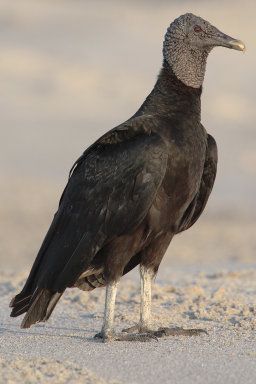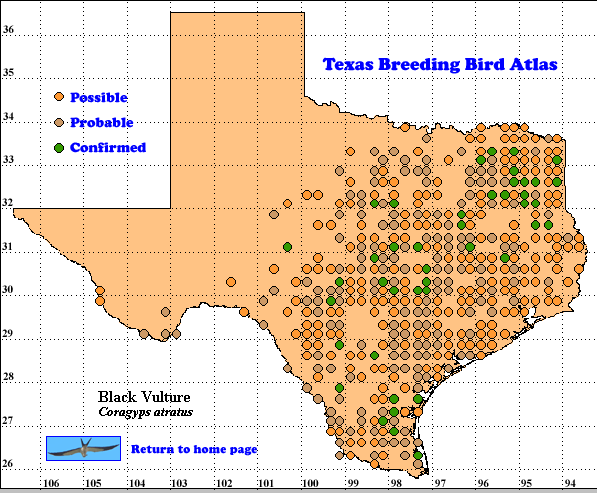Black Vultures and Turkey Vultures (Cathartes aura) associate in communal roosts and carrion feeding sites. They spend much of the day searching for carcasses; but, unlike Turkey Vultures, Black Vultures lack a highly developed sense of smell. To compensate, they exploit the odor-detecting ability of Turkey Vultures to locate carrion; then, Black Vultures follow Turkey Vultures to carcasses where Black Vultures become aggressive and displace Turkey Vultures from the food. Black Vultures maintain monogamous, long-term pair bonds and may feed their young for as long as 8 months after fledging; thus, maintaining strong social kin bonds (Buckley 1999).
DISTRIBUTION: The Black Vulture is a common to locally abundant resident in the eastern two-thirds of Texas. The species is a casual summer and fall visitor to the southern High Plains and most of the Rolling Plains and, is a locally uncommon resident in the Trans- Pecos ecoregion along the Rio Grande from eastern Val Verde County to northern Presidio County (Lockwood and Freeman 2004). Formerly, Black Vultures bred northwest of their present range to Wise, Young, and Wilbarger counties. The latest breeding was in Wilbarger County was at Vernon with eggs taken, Apr. 21, 1930 (Oberholser 1974).
SEASONAL OCCURRENCE: Black Vultures are resident (largely). They breed from late January to August; based on egg dates from January 28-July 29 and young in the nest.from April 4 to August 21 (Oberholser 1974). During winter, in northern portions of their range in Texas, some individuals retreat southward; but the population may continue to be locally common as they are replaced by migrants from more northern locations (Lockwood and Freeman 2004). BREEDING HABITAT: Nest sites of Black Vultures, like those of Turkey Vultures, are best described as “dark recesses” in a great variety of places, e.g., caves, hollow trees, brush piles, old abandoned buildings, crevices among rocks, tangles of low vines or other low vegetation, and beside or under trees and logs. Bottomland hardwoods and “thickets” (tangles of low vegetation) are predominant among forest habitats. However, Black Vultures make greater use of thickets and less use of hollow trees, logs and stumps than Turkey Vultures. Wherever available, caves in rocky cliffs are also favored (Jackson 1983, Buckley 1999).
No nest is built and the eggs are laid directly on the substrate of the site. Pairs will continue to use a nest site for many years as long as their breeding is successful (Buckley 1999). For example, in central Texas, a brush pile nest site was reused 9 times, and 3 of 6 nest sites in limestone caves were used annually for 15 years. Also, in central Texas, 11 of 12 nesting attempts (including 1 renesting) in a 30 ha (74 acre) semi-natural suburban ravine produced 2 fledglings per successful nest (91.7% success), or 1.83 fledglings per attempt. In a nearby 80 ha (198 acre) semi-natural, rural recreational area, 44 of 46 attempts (including 1 renesting) also produced 2 fledglings per successful nest (95.5% success), 1.89 fledglings per attempt (F. R. Gehlbach pers. comm. in Buckley 1999).
STATUS: Black Vultures increased markedly in Texas after 1920 apparently in response to increasing numbers of domestic cattle and sheep. However, rancher concerns about vultures spreading disease or attacking weak or sick calves, lambs, and other vulnerable livestock led to intensive control efforts in which thousands of vultures were
killed after being caught in walk-in traps, poisoned, or shot (Parmalee 1954). However, there was no evidence that Black Vultures are significant vectors of diseases and, indeed, some disease organisms are destroyed in the vulture gut. Removal of carcasses may significantly reduce the spread of diseases in areas where sanitation is rudimentary (Buckley 1999). Nevertheless, trapping, poisoning, and shooting of vultures continued at least until the early 1970s (Mossman 1991).
In vulture eggs collected in Texas (1948-1956), DDT contamination reduced eggshell thickness (>20% lower than normal) in a large percentage of eggs, undoubtedly leading to egg losses and reduced breeding success (Kiff et al. 1983).
Trees large enough to contain a suitable nest site are 100-150 years old and are hollow as a result of fungal rot and fire injuries. However, commercially valuable trees are generally harvested before they are 100 years old and fire is prevented and controlled (Jackson 1983). Also, bottomland forests have been greatly reduced by reservoir construction and inundation and adjacent development (Gunter and Oelschlaeger 1997, Telfair 1999). Mortality data (Jackson 1983) suggest tree cavity nests are safer than more exposed thicket nets. However, analyses of nest site use before and after 1920 show tree cavity nests have declined from 27 to 10% and thicket nests have increased from 33 to 54% (Jackson 1983).
Other important factors adversely affecting Black Vulture populations are loss of roost trees, disturbance of nest and roost sites, and highway mortality when vultures are struck while feeding on animals killed by vehicles (Wilbur 1983, Buckley 1999).
However, North American Breeding Bird Survey data for Texas (Sauer et al. 2005) give annual trends of 3.8% (1966-1979), 5.4% (1980-2005), and 4.9% (1966-2005); thus, showing a significant increase. However, there are regional differences: e.g. Upper Coastal Plain (8.3% 1966-1979, 6.8% 1980-2005, 7.9% 1966-2005), Coastal Prairies (-8.5% 1966-1979, 6.6% 1980-2005, 8.4% 1966-2005), East Texas Prairies (8.1% 1966-1979, 4.6% 1980-2005, 5.6% 1966-2005), Edwards Plateau (14.3% 1966-1979, 9.0% 1980-2005, 8.7% 1966-2005), and South Texas Brushlands (-5.9% 1966-1979, +2.0% 1980-2005, -3.2% 1966-2005). Contributing factors to the overall increase in numbers of Black Vultures may be the increasing availability of road-killed animals and less vulnerability than Turkey Vultures to collision with passing vehicles while feeding (RCT).
Text by Raymond C. Telfair II (2007)
Literature cited.
Buckley, N. J. 1999. Black Vulture (Coragyps atratus). InThe Birds of North America, No. 411 (A. Poole and F. Gill, eds.). The Birds of North America, Inc., Philadelphia, PA.Gunter, P. A. Y. and M. Oelschlaeger. 1997. Texas land ethics. University of Texas Press, Austin.
Jackson, J. A. 1983. Nesting phenology, nest site selection, and reproductive success of Black and Turkey Vultures. In Vulture biology and management, pp. 245-270 (S. R. Wilbur and J. A. Jackson, eds.). University of California Press, Los Angeles.
Kiff, L. F., D. B. Peakall, M. L. Morrison, and S. R. Wilbur. 1983. Eggshell thickness and DDE residue levels in vulture eggs. In Vulture biology and management, pp. 440-458 (S. R. Wilbur and J. A. Jackson, eds.). University of California Press, Los Angeles.
Lockwood, M. W. and B. Freeman. 2004. The TOS handbook of Texas birds. Texas A&M. University Press, College Station.
Mossman, M. J. 1991. Black and Turkey Vultures. Pp. 3-22 in Proc. Midwest Raptor Mgmt. Symp. and Workshop. Natl. Wildl. Fed., Washington, DC.
Oberholser, H. C. 1974. The bird life of Texas. University of Texas Press, Austin.
Parmalee, P. W. 1954. The vultures, their movements, economic status, and control in Texas. Auk 71: 443-453.
Sauer, J. R., J. E. Hines, and J. Fallon. 2005. The North American Breeding Bird Survey, results/analysis 1966-2005. Version 6.2.2006. USGS Patuxent Wildl. Res. Cnt., Laurel, Maryland. http://www.mbr-pwr.usgs.gov/bbs/bbs.html.
Telfair, R. C. II, ed.. 1999. Texas wildlife resources and land uses. University of Texas Press, Austin.
Wilbur, S. R. 1983. The status of vultures in the western hemisphere. In Vulture biology and management, pp. 113-123 (S. R. Wilbur and J. A. Jackson, eds.). University of California Press, Los Angeles.

